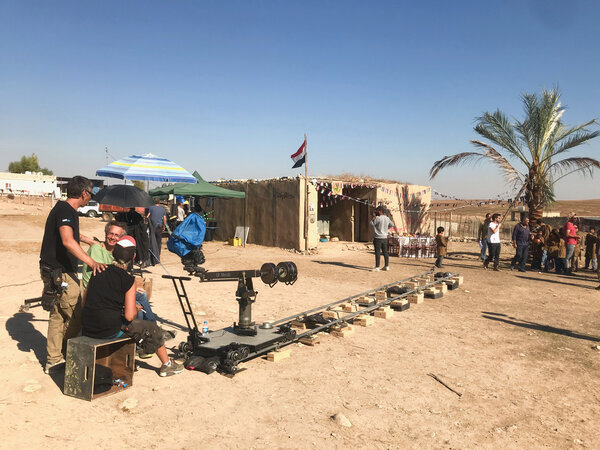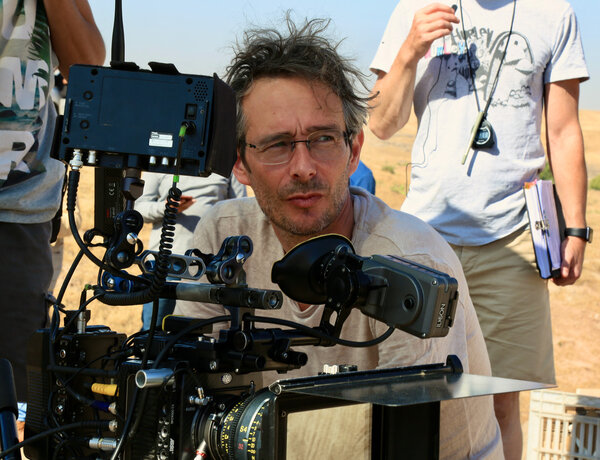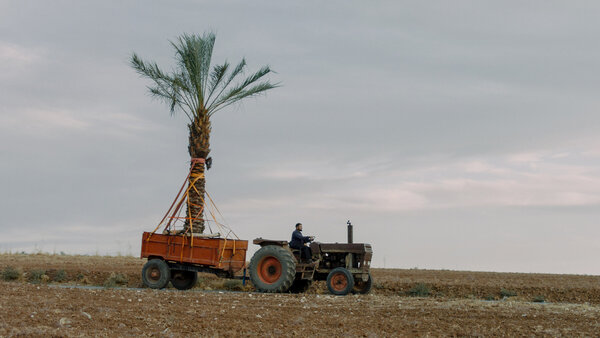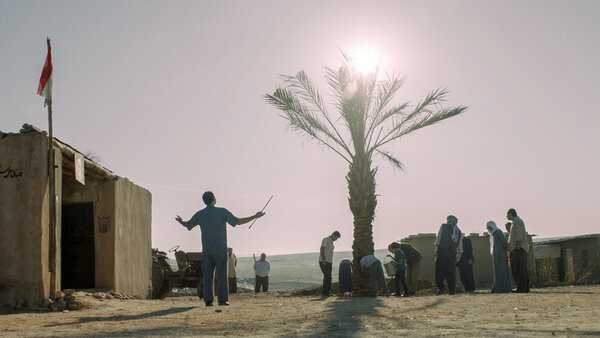Camerimage 2021
Stéphane Kuthy, SCS, discusses the shoot of "Neighbors", by Mano Khalil
The Tragic and the AbsurdIn a Syrian border village in the early 1980s, young Sero is in his first year of school. He and his classmates play insolent pranks, he dreams of a television set to finally be able to watch cartoons, and notices that the adults around him are increasingly crushed by despotism and nationalist violence. A new teacher arrives to transform the young Kurdish children into good and loyal pan-Arab comrades.
Few cinematographic projects have described the life of Kurds in Syria. How did you go about recreating it ?
The film was shot in Iraqi Kurdistan. This was the nearest place we were able to make this film. Shooting in Syria was obviously impossible, as it was in Turkey. The only other possibility was Iran, but that was difficult, too. Mano Khalil, who is Kurdish himself, knew the area well, as he had already shot there. Still, there were real difficulties in finding equipment and personnel. For the camera, for example, we had to have it shipped from Istanbul by road, with all of the problems that can cause. Happily, we were able to locate a renter in Erbil, the capital of Kurdistan, who supplied us with the lighting and the grip equipment. We had five weeks on location for scouting and making the shooting script.

Did you have to build sets ?
The little village, with its houses, its school and its mosque, were partially reconstructed by the set designers on the basis of what already existed. Other sets, such as the border post, were harder to find. We took advantage of a large farm that had a big chain-link fence and transformed it into a checkpoint. The rest of the exteriors, and everything shot near the border, were shot in many different locations, all of which were far from one another. Some exteriors had even already been shot by a second crew, six months prior to our arrival. In particular, the scenes at the end of the film where our young protagonist is walking alone in nature. The vegetation is very different in that scene, green and lush, unlike the dry and burnt late summer landscape that we encountered when we began the main production in September 2020. The heat was stifling and would rise to 40°C by late morning. That caused us to take breaks in the middle of the day and to prefer shooting early in the morning or late in the evening.
For the many interior / dusk scenes, we shot in daytime using tents around the locations to eliminate any daylight and recreated the twilight outside of the windows.
How many days did shooting last ?
We shot for 40 days, which might seem comfortable, but given the presence of children and the heat, it wasn’t that comfortable. Besides the young main protagonist, all of the other children were from refugee camps, such as the one where the prologue and epilogue are set. This was, of course, their first experience in front of the camera. Beyond that, it was also a total break with their daily lives. It was a moment of friendship and of shared experience, even though the language barrier often stopped us from communicating easily with them. With each passing day, I felt them become more at ease with the camera, and they became relaxed and would laugh easily. What’s more, the classroom location was extremely small. There was hardly enough room to set down the branches… The existing buildings had been entirely adapted inside by the set designers. The only problems we noticed when we arrived : the presence of electric poles and lines that didn’t match the village as described in the screenplay. Indeed, the village wasn’t supposed to have been electrified yet, and that is one of the changes that takes place during the film. We first considered the possibility of getting rid of them digitally, but finally we decided to make them part of the set design, by imagining that the network hadn’t yet been connected.

Let’s discuss the school a bit. That’s a location that takes on a great deal of importance for the young hero.
We considered rebuilding an interior location for that room so that we could have a bit more room and a bit more freedom for the camera. But that was complicated because of having to manage the children between interior and exterior shots. So, we shot everything inside that little room and used the two existing light entrances, namely the door, which lights the chalkboard and the schoolmaster from the side, and the little window at the back. In terms of lighting, I shot almost all of those scenes using a 6 kW HMI as the main source for the door, and 2 4kWs crossed at the back of the room to make the students stand out a bit. A simple reflector allowed me to manage the contrast on their faces. There was also a little differentiation of colour between those two sources : the light coming in through the door was a bit warmer, on the order of a fourth or a half CTO.
The film adopts a conservative editing style with few directorial effects. Such as the sequence that follows the gunshot from the watchtower.
One of our influences was Iranian cinema from that time, and namely Kiarostami’s films in the rhythm of our editing style and through certain camera angles. There are few closeups in this film and if you take the sequence where the uncle rushes towards the customs agents, there aren’t any at all. Once our decision to shoot at dusk had been made, we were also rather limited to one camera in terms of angles. I remember that shooting bodies and gestures seemed nearly impossible at that time. But generally speaking, I think we mostly kept it simple in the way we shot this film and didn’t try to catch the viewer’s eye too much. We wanted to allow the viewer time to observe what is happening. We didn’t want to overdramatise the memories, since we felt that those things were already well represented in the screenplay.
In any case, that location was very cinematographic.
It’s true that nature plays a role in this film, and we were lucky with that location. It was a little green valley, not far from the village, that we could easily access. We were able to build the border post in the background with almost 270° we could use on that set. The sunsets in that area are incredible in late summer. There is an enormous amount of particulate material in the air at that time of year, as it is when the farmers burn their fields. I have rarely seen such light elsewhere and we didn’t hesitate to use it in some sequences, such as the one where the secret service car brings the uncle home after his arrest. I think that scene’s image is almost biblical !

What equipment were you able to obtain ?
As the shoot took place in difficult conditions (heat, dust, etc.), I wanted to take reliable equipment with me. Along with the Alexa Mini, I chose a Cooke S4 series, instead of shooting with vintage lenses and risking a breakage or other damage. I like these lenses a lot, but I did have to soften them down a vit. Everything that took place in the past, meaning 95% of the film, was filtered with a soft FX ½, and we applied a light fake film grain in postproduction.
Did you use LUTs on set ?
Generally speaking, I like to work simply, by displaying the basic Rec 709 LUT on the camera, and then finding the definitive look with the colourist later on. On this period film, I did make an exception, because I thought it would be important to have something on set that would be evocative of the period. So, I prepared 3 LUTs beforehand (ext night, day, and interior), taking inspiration from work by Alex Webb and Susanne Meiselas of Magnum, both of whom shot Turkey and Kurdistan in the 1980s. I had their magenta skies and vibrant reds in mind. After shooting, we did walk it back a bit, particularly because it seemed to us that the beige of the ground had been a bit too eliminated, whereas it was omnipresent in the film. In the end, I’m not sure that it’s truly a time saver to try and offer a semi-finished image on set. The power of postproduction tools is so great that so long as it looks ok to me in the viewfinder or to the naked eye on set, I always get what I want in postproduction. That’s also a way to foster a relaxed attitude and communicate it to the director.
In the last part of the film, the hero’s father goes to the city to renew their identity papers.
For that sequence, we were able to shoot on location in the city archives. This is a unique moment because it’s the first time the characters are lit by electric lights in the entire film. I tried to play the fluorescent tube card, by using existing lighting, and keeping a certain idea of the Southern sun that penetrates the location.
I wanted to maintain contrast to enhance the drama. The director wanted to vary angles as much as possible to transpose the piles of files on screen and reproduce the labyrinth the protagonist must make his way through. I really like the inverted relationship of submission between the standing person who is dominated and the seated person who looks him up and down.
Those absurd touches of humour are present throughout the film.


Yes, the palm tree sequence is also totally in the same tone.
Indeed, there are no palm trees in Kurdistan. It’s too cold in the winter. The scene was a problem for us, because we didn’t know until the day before whether the palm tree would be delivered ! Finally, it was. A bit like in the film. We were delighted. The shot where it appears at the bottom of the shot came to me as I was thinking about the road and the grasses that surround it. A bit like cotton candy emerging from the earth. With the Kurdish police helicopters overflying our roadblock outside of the frame, intrigued by our strange setup. It was a truly surrealist moment both in front of and behind the camera.
A word about the contemporary refugee camp scene that you use as both a prologue and epilogue ?
I thought initially I would change lenses for that scene, and maybe use Master Primes, which have a very different structure. But given the difficulties of obtaining camera equipment, I had to settle for just removing the SFX filter and not adding grain in postproduction, as I did on the rest of the film. The sequence was directed with the will of not beginning a new scene, but just to see the characters meet again. The last shot is the only traveling shot in the whole film, used to emphasize the power of this moment.
In your opinion, what is the most important shot in a film : the first or the last ?
In order to be selected by a festival, maybe the first, no ? Seriously speaking, every shot is important in a film. It’s important to identify the key scenes in a film, and to think about them especially hard and to make sure you’ll have enough time during shooting so that you won’t mess them up for the wrong reasons.
(Interview by François Reumont, and translated from French by A. Baron-Raiffe, for the AFC)
Neighbors
Director : Mano Khalil
Producer : Frame Film
Set Design : Sara B. Weingart
Sound : Mourad Keller
 En
En Fr
Fr





